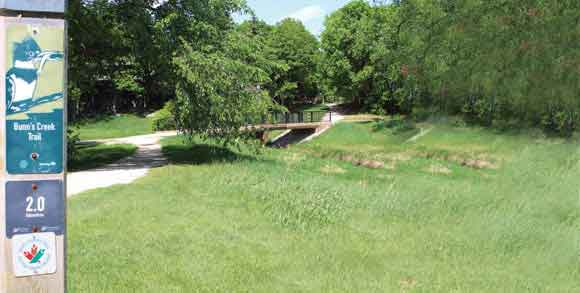The Rural Municipality of North Kildonan was established in January 1925 after residents of its north ward petitioned the legislature to allow it to split from East Kildonan.
There had been growing tensions between the rapidly urbanizing southern wards of the municipality, which required more tax money each year to pay for the necessary big-ticket infrastructure improvements, and those living in the north who wanted to maintain its rural, agricultural nature and the low property tax rates that went with it.
North Kildonan amalgamated with the City of Winnipeg in 1972 as part of Unicity.
Bunn’s Creek and Bunn’s Creek
Centennial Park (1970)
The most prominent geographic feature in North Kildonan is Bunn’s Creek which meanders for three kilometres between the Red River and Raleigh Street.
The name Bunn’s Creek can be found as far back as the 1850s in the minutes of the Council of Assiniboia, Rupert’s Land’s legislative body. It was named to honour the Bunn family, early settlers of what is now Manitoba.
John Bunn, for instance, was born here and went to Scotland to train as a physician. When he returned to set up a practice in 1824 he was at times the region’s only doctor, making him a very important man. He also served on the council as a medical advisor and public works chair.
Bunn’s Creek’s main function for nearly fifty years was that of a sewer. Between 1911 to the late 1960s, Domtar’s wood treatment plant in Transcona drained its toxic waste ditch into the creek. During much of that time, farmhouses could also use it to dispose of effluent. The creek’s annual spring flooding flushed most of the offending material away into the Red River.
By the 1960s, the municipality stepped up investment in its residential sewer system for its growing network of streets and dumping into Bunn’s Creek was declared illegal.
In 1969, North Kildonan’s municipal council decided that a park adjacent to Bunn’s Creek would be its official Manitoba centennial project.
There was opposition from some residents and assembling the 23-acres of land through purchase and expropriation took longer than expected. The site was dedicated in the afternoon of December 30, 1970, just hours to spare for it to be considered a centennial project and entitled to a provincial grant. The work of clearing brush and establishing a playground on the site did not take place until the following spring.
After North Kildonan became part of Winnipeg in 1972, Bunn’s Creek Centennial Park became the city’s responsibility and it soon chose to make major improvements to it.
In February 1974, city council approved plans to create a walkway along the entire length of the creek. This meant acquiring nearly 75 acres of land on each side of the waterway from dozens of landowners. Other improvements announced that year were the construction of a toboggan slide, expanded playground, a picnic area and, eventually, an indoor winter shelter for its skating rink.
The Bunn’s Creek Centennial Park and Bunn’s Creek Trail are part of the Trans Canada Trail system.
Former Municipal Hall (1956)
1400 Henderson Highway
When North Kildonan became a rural municipality in 1925, it set up its municipal offices on the second floor of the Imperial Bank Building at Main Street and Bannatyne Avenue. This may seem an odd location, but the municipality itself owned no built infrastructure aside from a shed for the volunteer fire department’s truck. What started out as temporary accommodation became its home for the next 31 years.
By 1956, North Kildonan’s population had grown to nearly 4,500 and the urban development it once turned its back on was now being embraced. With numerous expensive civic infrastructure projects about to take place in the municipality it was felt that the council and its officials needed to be closer to the action.
Its new municipal office building was constructed in 1955 – 56 at a cost of nearly $30,000. It is 4,700 square feet in size spread over the main floor and full basement.
The official opening took place on March 16, 1956 in front of a crowd of over 200 people. Mayor Jack Pierce presided over the ceremonies. The first council meeting was held in the building ten days later.
The small, passive park that surrounds the building was named John Dixon Park in 1969. Scottish-born Dixon served for five years on the North Kildonan school board and was elected mayor in 1957, 1959 and 1961. He died of a heart attack while in office on December 14, 1961 at the age of 57.
Located at the west end of the park is North Kildonan’s only war memorial, which wasn’t erected until 1968.
On December 31, 1971, the Rural Municipality of North Kildonan was dissolved and the building became property of the City of Winnipeg. Through the 1970s and 80s the province used the site for a number of services, including those of its department of health and social development.
A major renovation of the building took place in 2007 so that it could be used as a Winnipeg Police Service Centre, which occupied the space from 2008 until 2014.
The building is currently empty and still owned by the city of Winnipeg.
Christian Cassidy writes about local history at his blog, West End Dumplings.



